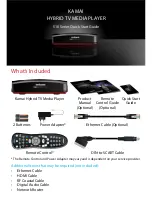
Basic Operation
R&S
®
ZVA-Z90E / -Z110E
19
Getting Started 1307.7197.62 ─ 08
3
Basic Operation
This chapter describes the use of an R&S ZVA vector network analyzer and two
R&S
ZVA-Z110E frequency converters for 2-port transmission measurements.
Measurements using other converter types are performed in an analogous way.
3.1
Required Equipment
Measurements with frequency converters can be carried out with the following equip-
ment:
●
Network analyzer (NWA) R&S ZVA with an upper frequency limit of 20 GHz or
higher (R&S ZVA 24, R&S ZVA40 ...).
The required firmware version depends on the frequency converter model:
–
R&S ZVA-Z110E: at least version V2.61
–
R&S ZVA-Z90E: at least version V2.70
●
Two NWA ports per frequency converter port.
Alternatively: One NWA port per frequency converter plus a common external gen-
erator for the LO signals. The R&S SMF100A signal generator with suitable options
is recommended.
●
N frequency converters for an N-port measurement
●
Option R&S ZVA<n>-B16, "Direct Generator/Receiver Access" at each port
●
Option R&S ZVA-K8, "Converter Control"
●
Option R&S ZVA-B8 to establish the control connection between the NWA and the
frequency converters
●
a suitable set of calibration standards
3.2
Measurement Principle
The frequency converters use frequency multipliers to transform the RF source signal
from one of the network analyzer ports into a high-frequency stimulus signal. A second
signal (Local Oscillator, LO) is used for down-conversion of the reference and mea-
surement channels. The LO signal can be provided either by a second analyzer port or
by an external generator.
The measurement involves the following steps:
1. Selection of the converter and test setup, activation of the converter mode
2. Entry of power coefficients (when a converter is used for the first time or assigned
to a new analyzer port).
3. Connection of the frequency converters
4. Power and frequency settings
Measurement Principle









































